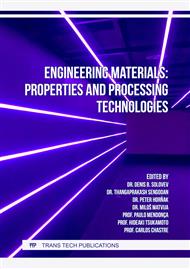[1]
M. Saeedifar, et al., Clustering of interlaminar and intralaminar damages in laminated composites under indentation loading using Acoustic Emission, Compos. B. Eng. 144 (2018) 206-219.
DOI: 10.1016/j.compositesb.2018.02.028
Google Scholar
[2]
T. Bohmann, M. Schlamp, I. Ehrlich, Acoustic emission of material damages in glass fibre-reinforced plastics, Compos. B. Eng. 155 (2018) 444-451.
DOI: 10.1016/j.compositesb.2018.09.018
Google Scholar
[3]
C. Ramesh, et al. Effect of hydrolytic ageing on Kevlar/polyester using acoustic emission monitoring, J. Nondestruct. Eval. 31 (2) (2012) 140-147.
DOI: 10.1007/s10921-012-0129-9
Google Scholar
[4]
D.D. Doan, et al., An unsupervised pattern recognition approach for AE data originating from fatigue tests on polymer–composite materials, Mech. Syst. Signal Process. 64 (2015) 465-478.
DOI: 10.1016/j.ymssp.2015.04.011
Google Scholar
[5]
T.P. Philippidis, T.T. Assimakopoulou, Strength degradation due to fatigue-induced matrix cracking in FRP composites: An acoustic emission predictive model, Compos. Sci. Technol. 68 (15-16) (2008) 3272-3277.
DOI: 10.1016/j.compscitech.2008.08.020
Google Scholar
[6]
M. Ohtsu, K. Ono, Pattern recognition analysis of acoustic emission from unidirectional carbon fiber-epoxy composites by using autoregressive modeling, JAE. 6 (1987) 61-71.
Google Scholar
[7]
H. Heidary, et al., Clustering of acoustic emission signals collected during drilling process of composite materials using unsupervised classifiers, J. Compos. Mater. 49 (5) (2015) 559-571.
DOI: 10.1177/0021998314521258
Google Scholar
[8]
W. Zhou, P. Zhang, Y. Zhang, Acoustic emission based on cluster and sentry function to monitor tensile progressive damage of carbon fiber woven composites, Appl. Sci. 8 (11) (2018) 2265.
DOI: 10.3390/app8112265
Google Scholar
[9]
M. Nazmdar Shahri, et al., Damage evaluation of composite materials using acoustic emission features and Hilbert transform, J. Compos. Mater. 50 (14) (2016) 1897-1907.
DOI: 10.1177/0021998315597555
Google Scholar
[10]
N. Godin, P. Reynaud, G. Fantozzi, Challenges and limitations in the identification of acoustic emission signature of damage mechanisms in composites materials, Appl. Sci. 8 (8) 2018 1267.
DOI: 10.3390/app8081267
Google Scholar
[11]
P. Pineau, F. Dau, Subsampling and homogenization to investigate variability of composite material mechanical properties, Comput. Methods Appl. Mech. Eng. 241 (2012) 238-245.
DOI: 10.1016/j.cma.2012.06.003
Google Scholar
[12]
L. Calabrese, G. Campanella, E. Proverbio, Noise removal by cluster analysis after long time AE corrosion monitoring of steel reinforcement in concrete, Constr. Build. Mater. 34 (2012) 362-371.
DOI: 10.1016/j.conbuildmat.2012.02.046
Google Scholar
[13]
D. Crivelli, M. Guagliano, A. Monici, Development of an artificial neural network processing technique for the analysis of damage evolution in pultruded composites with acoustic emission, Compos. B. Eng. 56 (2014) 948-959.
DOI: 10.1016/j.compositesb.2013.09.005
Google Scholar
[14]
M.G.R. Sause, On Use of Signal Features For Acoustic Emission Source Identification in Fibre-Reinforced Composites, JAE. 35 (2018) 129-140.
Google Scholar
[15]
W. Zhou, et al. Cluster analysis of acoustic emission signals and deformation measurement for delaminated glass fiber epoxy composites, Compos. Struct. 195 (2018) 349-358.
DOI: 10.1016/j.compstruct.2018.04.081
Google Scholar
[16]
N.Z. Karimi, G. Minak, P. Kianfar, Analysis of damage mechanisms in drilling of composite materials by acoustic emission, Compos. Struct. 131 (2015) 107-114.
DOI: 10.1016/j.compstruct.2015.04.025
Google Scholar
[17]
R. Gutkin, et al., On acoustic emission for failure investigation in CFRP: Pattern recognition and peak frequency analyses, Mech. Syst. Signal Process. 25 (4) (2011) 1393-1407.
DOI: 10.1016/j.ymssp.2010.11.014
Google Scholar
[18]
R. De Oliveira, A.T. Marques, Health monitoring of FRP using acoustic emission and artificial neural networks, Comput. Struct. 86 (3-5) (2008) 367-373.
DOI: 10.1016/j.compstruc.2007.02.015
Google Scholar
[19]
M. Enoki, Y. Muto, T. Shiraiwa, Evaluation of deformation behavior in LPSO-magnesium alloys by AE clusteringand inverse analysis, JAE. 33 (2016) 71.
Google Scholar
[20]
M.G.R. Sause, Acoustic emission source identification in large scale fibre reinforced composites, JAE. 33 (2016) S223-S223.
Google Scholar
[21]
A.A. Bryansky, et al., Investigation of the Staging of Damage Accumulation in Polymer Composite Materials during Bending and Tensile Tests, Key Eng. Mater. 887 (2021) 116-122.
DOI: 10.4028/www.scientific.net/kem.887.116
Google Scholar
[22]
J.P. McCrory, et al., Damage classification in carbon fibre composites using acoustic emission: A comparison of three techniques, Compos. B. Eng. 68 (2015) 424-430.
DOI: 10.1016/j.compositesb.2014.08.046
Google Scholar
[23]
W. Hao, et al., Acoustic emission monitoring of damage progression in 3D braiding composite shafts during torsional tests, Compos. Struct. 208 (2019) 141-149.
DOI: 10.1016/j.compstruct.2018.10.011
Google Scholar
[24]
R. Boominathan, et al., Acoustic emission characterization of the temperature effect on falling weight impact damage in carbon/epoxy laminates, Compos. B. Eng. 56 (2014) 591-598.
DOI: 10.1016/j.compositesb.2013.09.002
Google Scholar
[25]
F. Willems, J. Benz, C. Bonten, Detecting the critical strain of fiber reinforced plastics by means of acoustic emission analysis, JAE. 33 (2016) 261-270.
Google Scholar


